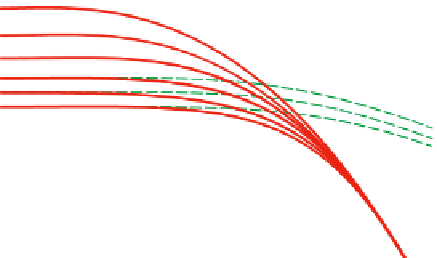Biomedical Engineering Reference
In-Depth Information
temperature T
0
if it is vertically and horizontally shifted according to the following
expressions for the horizontal shift factor a
T
and vertical shift factor bT:
T
:
a
T
≡
β
0
T
ðÞ
W
k
B
T
0
1
1
β ðÞ
¼
exp
;
ð
4
:
15
Þ
T
b
T
≡
ν
0
ð
T
0
Þ
T
0
T
:
ð
4
:
16
Þ
ν
0
ð
T
Þ
The fact that the frequency shift factor depends exponentially on the reciprocal of the
temperature indicates that the linear viscoelasticity is dominated by the activation process
of the junction dissociation.
The model predicts the viscosity at a stationary shear rate
η
sta
ðγÞ
and shows that the
characteristic shear rate for observing the shear thinning of the viscosity
-
determined, for
η
sta
ðγÞ
η
-
instance, by
=
(0)/2
is very sensitive to the choice of the disentanglement
β
-
function
Merz rule (
Chapter 2
) is not obeyed in such
systems.
Figure 4.7
shows this deviation, with dynamic viscosity falling below the steady
shear value.
This model successfully describes (i) the temperature scaling of the viscoelastic
moduli, (ii) the single relaxation time which controls the viscoelastic response, through
the chain breakage rate, (iii) the observation of a non-Newtonian behaviour (shear
thinning and shear thickening) and (iv) the breakdown of the Cox
(r). It also shows that the Cox
Merz rule.
Rheological measurements of HEUR type systems show good agreement with these
predictions. However, the concentration dependence of the high-frequency storage
modulus G
∞
in these systems does not follow the prediction of the TE model, which
-
0
β
0
=0
−
1
0.2
0.4
0.6
−
2
0.8
1.0
−
3
−
4
−
3
−
2
−
1
0
1
2
γ
ω
log
˙
,
Deviation from the Cox
-
Merz rule in associating polymers derived from the TE model.
Comparison between G
″
(
ω
)/
ω
versus
ω
(solid line) and
η
sta
ðγÞ
versus
Figure 4.7
ðÞ
(broken line). The
parameter
β
0
is varied from curve to curve. From Tanaka and Edwards (1992a) © 1992 Elsevier.
































Search WWH ::

Custom Search